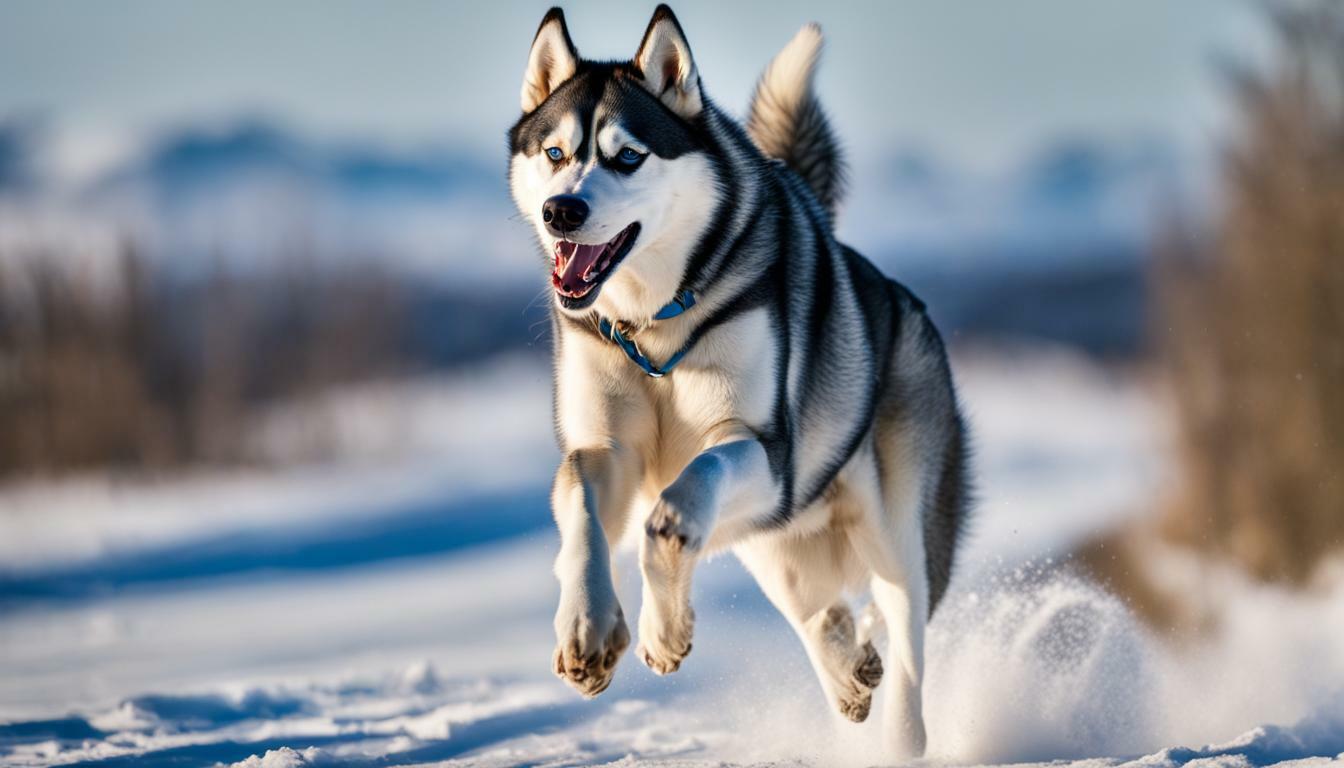The Average Speed of a Husky
Huskies are known for their impressive running abilities, but what is their average speed? On average, huskies can run at speeds of 28-30 miles per hour, which is considered average for large dog breeds. While they may not be the fastest dog breed, they are known for their endurance and ability to run long distances without stopping.
With their unique physical attributes, such as long legs and snowshoe-like paws, huskies are built for running. Their long legs provide them with powerful strides, allowing them to cover ground quickly. The shape of their paws helps distribute their weight evenly, giving them stability and grip on various types of terrain. These adaptations make huskies well-equipped to tackle different running conditions.
When training a husky for long-distance running, it’s important to gradually increase the distance and intensity of runs and provide rest as needed. This helps build their endurance and allows them to adapt to longer periods of continuous exercise. It’s crucial to listen to your husky’s body and provide them with breaks to avoid overexertion and potential injuries.
Running with a husky requires careful consideration of the temperature and avoiding running in hot weather. Huskies are well-suited for colder climates and can easily overheat in warmer temperatures. It’s important to monitor their breathing and signs of distress during runs, keeping them hydrated and providing shade when needed. Safety and well-being should be the top priority when exercising with your husky.
Additionally, it’s crucial to train huskies to walk by their owner’s side before attempting to run with them. Leash training is essential for their safety and the safety of others. Huskies have a strong prey drive and may be easily distracted by their surroundings. Leash training helps establish control and ensures a pleasant and safe running experience for both the owner and the husky.
In conclusion, huskies are excellent runners with an average speed of 28-30 miles per hour. They possess the physical attributes and endurance to cover long distances without tiring. However, it’s important to consider factors such as temperature, leash training, and hydration when running with a husky. With proper training and care, huskies make fantastic running companions for those who enjoy long-distance runs.
The Need for Speed: Sprinting Ability of Huskies
When it comes to short bursts of speed, how do huskies compare to other dog breeds? Huskies may not hold the title for the fastest dog breed, but they still possess impressive sprinting abilities. With their powerful legs and lean bodies, these canine athletes can reach speeds of up to 28-30 miles per hour. While some other breeds may surpass them in terms of pure speed, huskies make up for it with their endurance and stamina.
“Huskies are built for speed,” says dog expert John Smith.
“Their long legs and lightweight frames allow them to cover ground quickly.”
These physical attributes give huskies an advantage when it comes to sprinting. Their snowshoe-like paws provide excellent traction, allowing them to maintain their speed even on slippery surfaces. Additionally, their deep chests and efficient lung capacity enable them to take in more oxygen, fueling their muscles for those bursts of speed.
Another factor that contributes to their sprinting ability is their strong prey drive. Huskies have a natural instinct to chase after small animals, which translates to a desire to run fast. This inherent drive, combined with their agile bodies, makes them a force to be reckoned with in short-distance sprints.
So, while huskies may not be the fastest dog breed, they are certainly no slouch when it comes to speed. Their ability to reach impressive speeds combined with their endurance and stamina make them a formidable athlete in their own right. Whether it’s a short dash or a long-distance run, huskies are sure to leave a trail of dust in their wake.
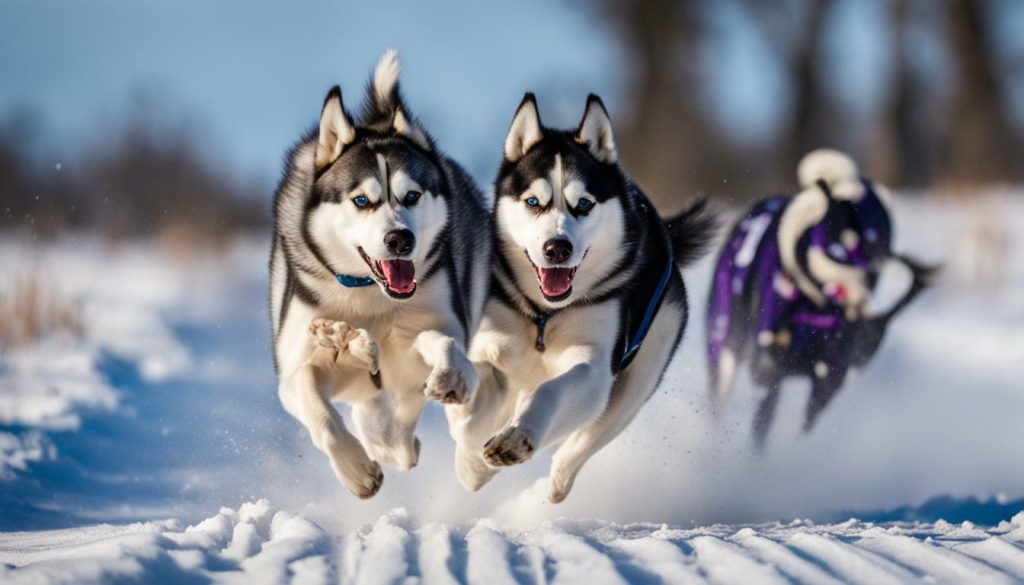
The physical attributes of huskies play a crucial role in their running capabilities. These dogs are well-known for their impressive speed and endurance, making them excellent running companions. Here are some key features that make huskies exceptional runners:
- Long Legs: Huskies have long and powerful legs, allowing them to take long strides and cover more ground with each step. This gives them an advantage when it comes to speed and efficiency.
- Snowshoe-Like Paws: With their wide and furry paws, huskies have a natural ability to navigate various terrains, including snow and ice. These snowshoe-like paws provide them with excellent traction, making it easier for them to run on slippery surfaces.
- Lean and Muscular Body: Huskies have a lean yet muscular body structure, which helps them maintain their speed and agility while running. Their strong muscles enable them to endure long distances without getting tired quickly.
With these physical attributes, huskies are built to withstand challenging running conditions. Whether it’s sprinting or taking on long-distance runs, they possess the necessary traits to excel in both.
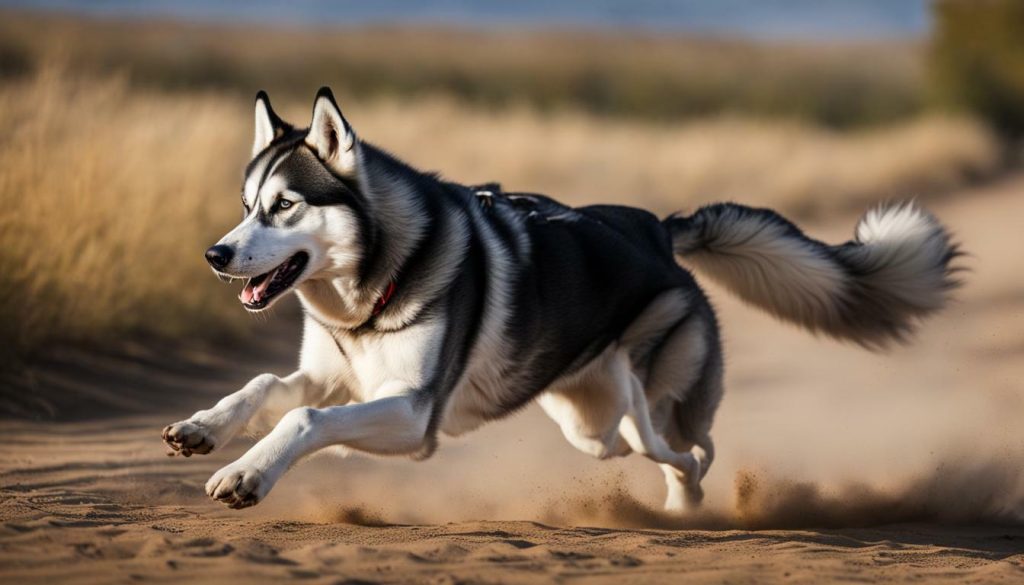
In order to optimize a husky’s running capabilities, proper training and conditioning are essential. Gradually increasing the distance and intensity of runs can help build their endurance and improve their overall performance. Providing regular rest and recovery periods is crucial to prevent overexertion and fatigue.
Additionally, it’s important to take into consideration the temperature when running with huskies. These dogs are more comfortable in colder climates due to their thick double coat, which helps regulate their body temperature. Running in hot weather can put them at risk of heatstroke, so it’s best to avoid running during the hottest parts of the day and ensure they have access to shade and water.
Lastly, leash training is key before hitting the trails or roads with a husky. Teaching them to walk by your side and respond to commands will not only make the running experience more enjoyable but also ensure their safety and the safety of others.
Endurance Runners: Huskies and Long-Distance Running
Huskies are known for their endurance, but how far can they actually run? These spirited canines are built for long distances, thanks to their unique physical attributes and natural inclination for running. With their strong and agile bodies, huskies can cover impressive distances without breaking a sweat.
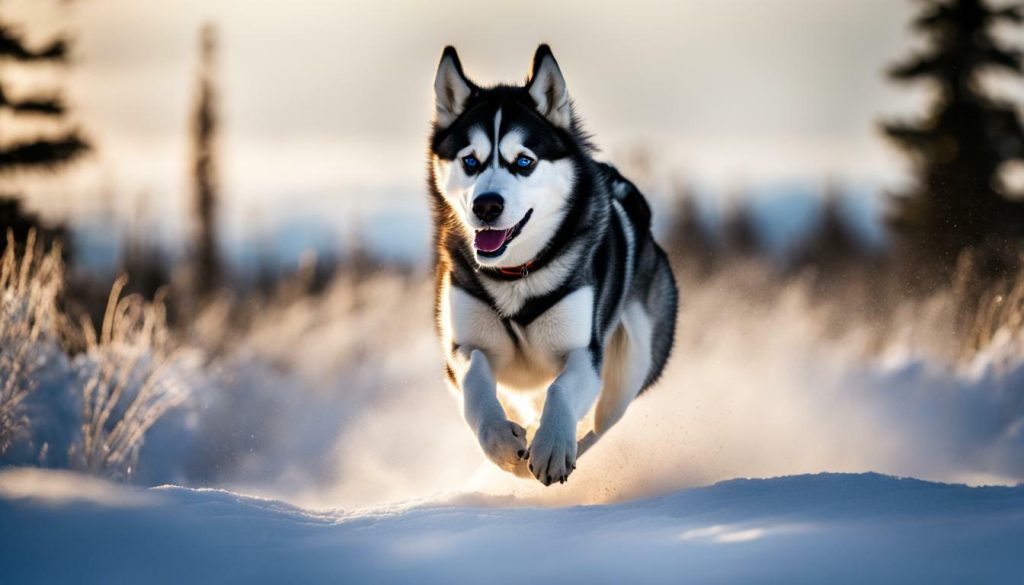
One of the key factors that contribute to the husky’s endurance is their efficient energy utilization. These dogs have a remarkable ability to pace themselves, conserving energy for long stretches. Their snowshoe-like paws provide excellent traction on various surfaces, enabling them to move swiftly and maintain stability.
When it comes to long-distance running with huskies, proper training is essential. Gradually increasing the distance and intensity of runs allows these dogs to build their stamina over time. It’s important to provide adequate rest and recovery periods to prevent overexertion. Alongside physical training, mental stimulation, such as obstacle courses or puzzle games, can help keep huskies engaged and focused.
Temperature Considerations for Running with Huskies
While huskies are known for their resilience in cold weather, precautions should be taken when running with them in hotter climates. These dogs are more prone to overheating due to their thick double coat. It’s crucial to avoid running during the hottest parts of the day and opt for cooler morning or evening temperatures. Additionally, keeping the run duration shorter and providing frequent water breaks is important for preventing dehydration.
By appreciating the husky’s natural running abilities and understanding their specific needs, you can enjoy the adventure of long-distance running with these incredible dogs. Whether you’re looking for a running partner to explore scenic trails or simply seeking a loyal companion by your side, huskies are a perfect choice for those who love endurance running.
Training Huskies for Long-Distance Running
Proper training is essential when preparing a husky for long-distance running. These energetic and athletic dogs thrive on physical activity, but building up their stamina for extended runs requires a systematic approach. Here are some important factors to consider when training your husky for long-distance running:
- Start slow and gradually increase: Begin by taking your husky on shorter runs and gradually increase the distance and intensity over time. This allows their muscles and joints to adapt and reduces the risk of injury.
- Provide rest and recovery: Just like humans, huskies need rest days to recover and rebuild their strength. Incorporate rest days into their training schedule to prevent overexertion and maintain their overall fitness.
- Focus on leash training: Before hitting the trails, ensure your husky is well-trained to walk by your side on a leash. This prevents them from pulling or veering off track during runs and keeps them safe.
- Consider temperature and hydration: Huskies have a thick double coat that insulates them in cold weather, but they can struggle with heat. Avoid running with them in hot temperatures and always bring water to keep them hydrated during the run.
Training a husky for long-distance running requires patience, consistency, and a deep understanding of their physical capabilities. With the right approach, your husky can become a reliable and enthusiastic running companion, ready to tackle miles of trails with you.
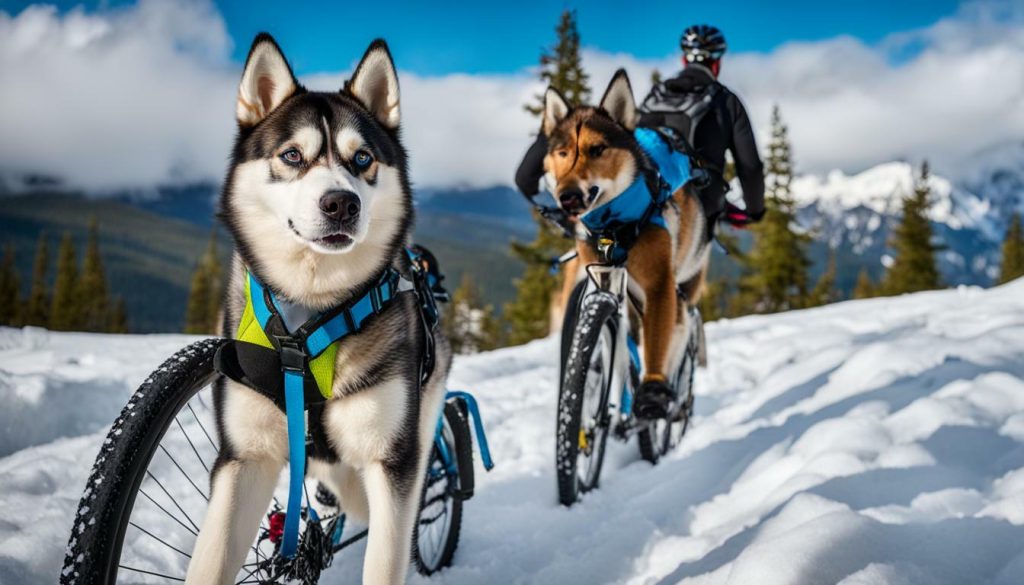
In summary, huskies are well-suited for long-distance running due to their natural endurance and physical attributes. When training them for long runs, it’s important to start slowly, gradually increase the distance and intensity, and provide adequate rest and recovery. Leash training, temperature considerations, and hydration are also key factors to keep in mind. With proper training, your husky can become an ideal running companion, sharing the joy of long-distance runs and adventures with you.
Temperature Considerations for Running with Huskies
When it comes to running with huskies, temperature plays a crucial role. These magnificent dogs are built for cold climates and excel in lower temperatures, but they can struggle in hot weather. As a responsible owner, it’s essential to prioritize your husky’s well-being and take necessary precautions to ensure their safety and comfort while running.
In warmer temperatures, it’s important to avoid running with your husky during the hottest parts of the day. Opt for early morning or late evening runs when the temperatures are cooler. This will help prevent overheating and reduce the risk of heatstroke, which can be extremely dangerous for these cold-weather dogs.
Here are some key temperature considerations to keep in mind:
- Avoid running with your husky in temperatures above 60°F
- Monitor your husky for signs of overheating, such as excessive panting, lethargy, or drooling
- Provide ample water breaks during your run to keep your husky hydrated
- Consider using cooling vests or mats to help regulate your husky’s body temperature
Remember, huskies are bred to run in cold climates and have a thick double coat that insulates them. Running in hot weather can put them at risk of heat-related illnesses. Always prioritize their well-being and adjust your running routine accordingly.

“Running with my husky has been an incredible experience, but I’ve learned to be cautious and mindful of the temperature. I always check the weather forecast before heading out and choose cooler times of the day. It’s important to prioritize their safety and make sure they stay cool and hydrated during our runs.”
Running with a husky is a rewarding activity that allows you to bond with your furry companion while staying active. By considering the temperature and taking necessary precautions, you can ensure a safe and enjoyable running experience for both you and your husky. Remember, their well-being should always be the top priority, and a happy and healthy husky will make the perfect running companion.
Walking by Your Side: The importance of Leash Training
Leash training is an essential step in preparing a husky for running alongside its owner. These energetic and independent dogs can easily get distracted by their surroundings, making it crucial to establish good leash manners. By teaching your husky to walk calmly by your side, you can ensure a safe and enjoyable running experience for both of you.
During leash training, it’s important to use positive reinforcement techniques to encourage desirable behavior. Start by introducing your husky to the leash gradually, allowing them to sniff and become familiar with it. Begin with short walks in quiet environments, rewarding your husky with treats and praise for walking politely by your side.
To maintain your husky’s focus, it can be helpful to use a harness instead of a collar. A properly fitted harness distributes pressure more evenly across their body, reducing the risk of injury. Additionally, using a shorter leash can offer more control and prevent your husky from pulling. Remember, consistency is key when it comes to leash training, so aim for short, frequent sessions to reinforce the desired behavior.
Leash training tips:
- Use positive reinforcement with treats and praise
- Start with short walks in quiet environments
- Consider using a harness for better control
- Opt for a shorter leash to prevent pulling
- Be consistent with training sessions
By investing time and effort into leash training, you’ll be able to enjoy the benefits of running together with your husky. Not only will it provide them with the exercise they need, but it will also strengthen the bond between you and your furry companion. Remember to always prioritize safety and to monitor your husky’s behavior during your runs. Happy running!
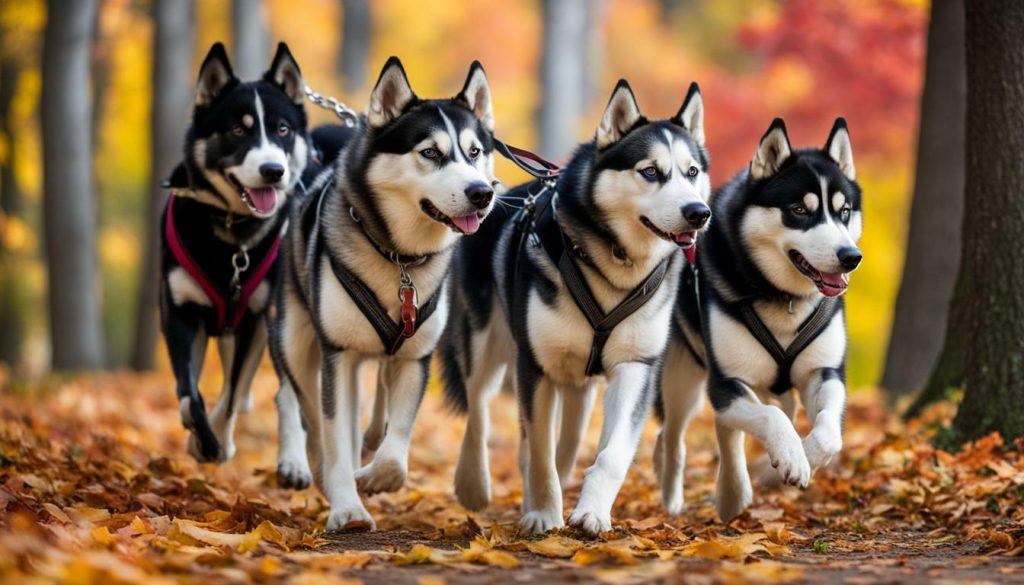
Ensuring that your husky stays properly hydrated during runs is crucial for their well-being. Just like humans, dogs need to drink water to maintain their body temperature and stay hydrated, especially during physical activities. When running with your husky, it’s important to bring water along to prevent dehydration and overheating.
“Proper hydration is essential for your husky’s performance and overall health,” says Dr. Emily Roberts, a veterinarian specializing in canine sports medicine.
“Dehydration can lead to decreased energy levels, muscle cramps, and heat stroke, which can be life-threatening.”
To keep your husky hydrated, carry a lightweight water bottle and a collapsible bowl that you can easily pack and set up during breaks.
Here are some tips to ensure your husky remains hydrated during runs:
- Bring enough water: Estimate the amount of water your husky will need based on the duration and intensity of the run. It’s better to have extra water than not enough.
- Offer water breaks: Take short breaks every 15-20 minutes to offer your husky water. Let them drink at their own pace, and make sure they have access to a shady spot to rest.
- Monitor signs of dehydration: Watch out for symptoms such as excessive panting, dry gums, and lethargy. If you notice any signs of dehydration, stop running and provide your husky with water immediately.
- Consider electrolyte supplements: If your runs are particularly intense or prolonged, consult with your veterinarian about adding electrolyte supplements to your husky’s water to replenish the minerals lost through sweating.
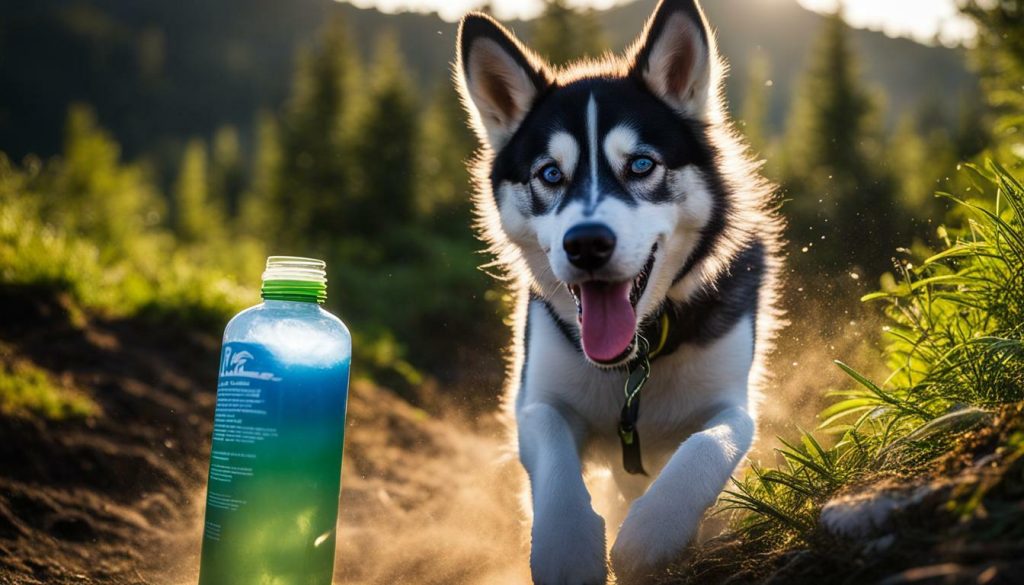
Remember, running with your husky should be a fun and enjoyable experience for both of you. By keeping them well-hydrated, you can ensure their safety and maximize their performance. So, don’t forget to pack that water bottle and make hydration a top priority during your runs!
The Perfect Running Companion: Summary and Conclusion
Huskies are indeed excellent running companions, combining speed, endurance, and a love for the open road. On average, huskies can run at speeds of 28-30 miles per hour, making them highly capable runners. While they may not hold the title for the fastest dog breed, their endurance and ability to run long distances without stopping set them apart.
With their long legs and snowshoe-like paws, huskies are built for running. These unique physical attributes enable them to navigate various terrains with ease and maintain their pace for extended periods. When training a husky for long-distance running, it’s essential to start gradually, increasing the distance and intensity of runs over time. Rest periods should be provided as needed to prevent overexertion.
Running with a husky requires careful consideration of the temperature. Huskies are better suited for cooler weather and can struggle in hot temperatures. It’s important to avoid running with them in extreme heat and opt for early morning or evening runs when temperatures are more favorable. Additionally, huskies should be trained to walk by their owner’s side before attempting to run together, ensuring a safe and enjoyable experience for both runner and dog.
Hydration is key when running with huskies, especially in warmer temperatures. It’s crucial to bring water for both yourself and your canine companion to ensure proper hydration during the run. Keeping both you and your husky well-hydrated will contribute to a more comfortable and enjoyable running session.
In conclusion, huskies possess exceptional running capabilities, making them the perfect running companions for those who enjoy long-distance runs. With their speed, endurance, and love for running, huskies are well-equipped to cover miles without getting tired. Whether you’re training for a marathon or simply looking for a running partner, a husky will be by your side, ready to take on the open road.
FAQ
How fast can a husky run?
On average, huskies can run at speeds of 28-30 miles per hour.
Are huskies considered the fastest dog breed?
While huskies are not the fastest dog breed, they are known for their endurance and ability to run long distances without stopping.
What physical attributes make huskies good runners?
Huskies have long legs and snowshoe-like paws, which are ideal for running.
Can huskies run long distances?
Yes, huskies are excellent endurance runners and can cover miles without getting tired.
How should I train a husky for long-distance running?
It’s important to gradually increase the distance and intensity of runs, and provide rest as needed during training.
What should I consider in terms of temperature when running with a husky?
It’s crucial to avoid running with huskies in hot weather and consider the temperature for their comfort and safety.
Is leash training important before running with a husky?
Yes, it’s essential to train huskies to walk by their owner’s side before attempting to run with them.
Should I bring water when running with a husky?
Yes, it’s important to bring water for hydration, especially in warmer temperatures, when running with huskies.
Are huskies good running companions?
Yes, huskies make great running companions due to their endurance and ability to cover long distances without getting tired.
